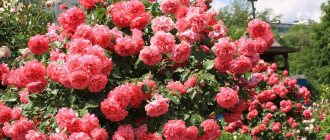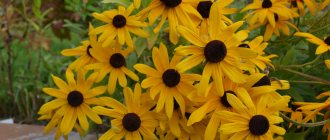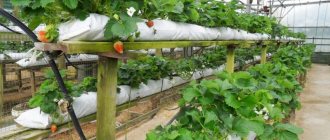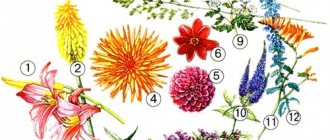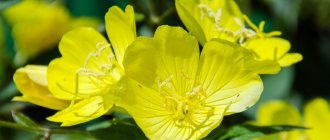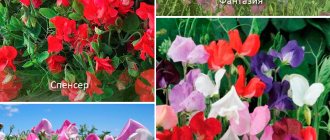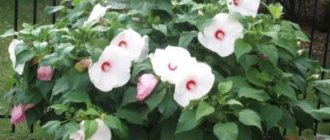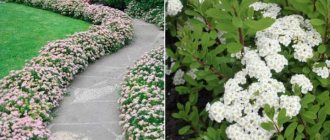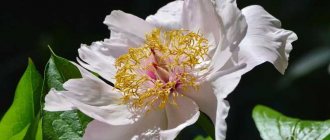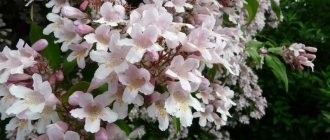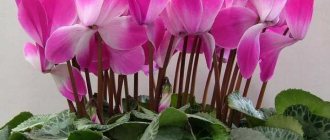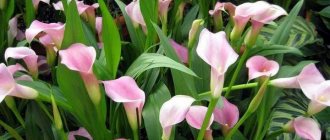Kniphofia berry
One of the species of the named genus. Distributed in southeastern Africa. It has been cultivated throughout the world as an ornamental plant since the beginning of the 18th century. It is on its basis that breeders have bred a large number of hybrids. The plant is tall, up to 1.2 m in height, with a powerful rhizome of a yellowish tint. The leaves are lanceolate, serrated along the edges, and gray-green. Flowers in buds are red, then can turn into orange, yellow, or carmine. Berry kniphofia, which is easy to plant and care for in open ground, will decorate any area. Almost all hybrids bred on its basis are distinguished by their high growth (up to 1.5 m in height) and good survival rate. The following varieties are especially popular:
- Dr Kerr - has a powerful meter-long peduncle with an inflorescence up to 20 cm long, lemon-yellow in color (pictured). Flowering duration is up to 60 days (from mid-summer).
- Orange Beauty is a hybrid with similar characteristics, the color of the flowers is bright orange.
- Fire Flame - the same flowering time, meter-long peduncle, but the inflorescence is slightly larger (25 cm) and has a scarlet-red hue.
Knifofia: planting and care in open ground
Despite the fact that growing plants is recommended mainly for southern regions with warm winters and hot summers, kniphofia takes root well in the more northern zone.
There are about 75 varieties of this flower , which are divided into several main types:
- Tukka is the most frost-resistant variety and takes root well in central Russia. Up to 80 cm in height, the inflorescence of kniphofia reaches 15 cm, flowering begins in July and lasts more than a month.
- Berry is a tall, hardy plant (up to 2 m), grown in open ground. It has a large inflorescence up to 25 cm, the flowering period is 65 days, and is the most decorative of all species. Most hybrid varieties have been bred on its basis.
- Hybrid - a group of garden plants bred by crossing the berry variety with other species. The height is less than natural (up to 130 cm), the flowers have different shades, all the basic qualities of kniphofia are preserved (duration of flowering, size of inflorescences, etc.).
- Makowan - has a length of 80 cm during the flowering period, inflorescences reach up to 10 cm. The buds are orange-red, yellow when blooming. Tolerates moisture well.
Knifofia in landscape design
Knifofia in landscape design photo
Exotic bushes with bright torch-colored inflorescences are excellent in group plantings. They are planted on alpine hills, in rocky gardens, rockeries, and mixborders. Tall bushes are excellent for planting along fences and structures, and are beautiful near a body of water, but the roots must be protected from dampness.
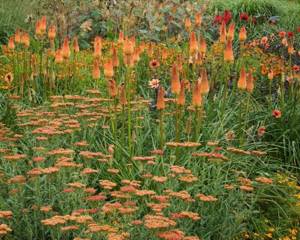
Knifofia with other flowers photo
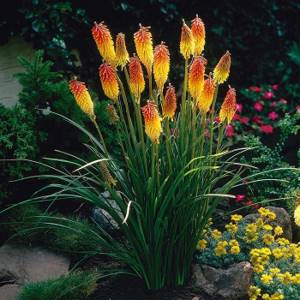
Knifofia in garden design photo
By the way, after cutting, the inflorescences retain their freshness for a long time and are often used in independent and composite bouquets.
Florists and flower growers advise planting kniphofia along with other large flowers. Such plantings look best near ponds, on mixed lawns and flower beds.
The peculiarity of the plant is the fact that it does not lose its decorative appearance throughout the entire growing season, which is why this flower can be used in landscape design. Kniphofia looks quite appropriate as a “soloist” in a flower bed or in combination with other flowering plants.
Knifofia against the background of a wicker fence.
The use of tall varieties will create a visual screen, and low varieties will decorate an alpine hill or rock garden.
Kniphofia as a border.
Kniphofia berry, looks great next to stones and conifers.
The most common companions of kniphofia in the flower garden are:
- sage, salvia;
- bearded iris;
- gypsophila;
- Eremurus;
- lupine;
- rudbeckia;
- dahlia.
Kniphofia and rudbeckia.
Ageratum Houstonianum, variety 'Blue Horizon', Kniphofia 'Flamenco', Salvia.
Kniphofia berry Flamenco and Alliums.
Kniphofia berry, Euphorbia, Verbena Buenos Aires, Macedonian bark.
Kniphofia goes well with heathers.
The flower bed can be framed by perennial cereal crops.
Kniphofia 'Shining Sceptre', Mycanthus sinensis 'Cabaret'
Linearifolia in combination with cortaderia (pampas grass).
Growing exotic plants in the garden is not as scary as it seems. Kniphofia, despite the fact that it comes from Africa, is not so demanding of care. And the appearance of bright torch-inflorescences will be the pride of the garden.
Application in landscape design
Knifofia fits perfectly into the design of any site. It can be planted with almost all garden crops. Tritoma gets along with:
- irises and sage;
- gypsophila and lupine;
- maned barley, other ornamental cereals and rhipsalis;
- santolina and sticky resin;
- dahlias and phloxes.
Attention! Blooming kniphophias retain their decorative value from mid-summer until autumn.
Planting options:
- Plant single tritomes in lawns or small flower beds.
- You can arrange different varieties of kniphofia on one ridge, making them the central plants.
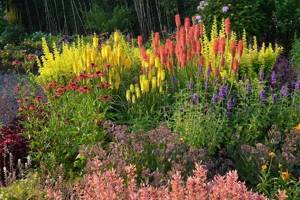
Neighbors in color should be contrasting - Kniphofias make a kind of screen that will help divide the garden into zones.
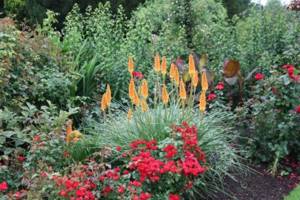
Yellow tritomes go well with red flowers and look good against the backdrop of green shrubs
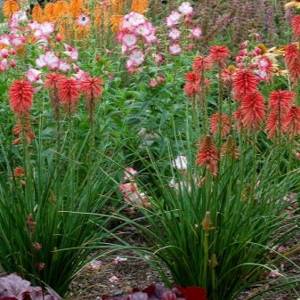
If you need to decorate an alpine slide, then with kniphofia it will look original
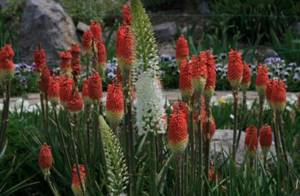
White grandiflora and bicolor tritoma are good neighbors
In areas with ponds, plants are planted on the shore.

On a sunny day, colorful ears of corn are reflected in the water
Species and hybrids
Genus Kniphofia
includes about seventy species.
Species and natural hybrids
List of species and natural hybrids, as well as infraspecific taxa.
Links to personal pages of taxa on the GRIN (Germplasm Resources Information Network) website are provided.
Kniphofia thomsonii
), Tanzania
Kniphofia uvaria
)
- Kniphofia alooides Moench = Kniphofia uvaria (L.) Oken
- Kniphofia brachystachya
Synonym: Tritoma caulescens (Baker) Carrière
- Kniphofia galpinii = Kniphofia triangularis
- Kniphofia hirsuta
- Kniphofia isoetifolia - Kniphofia isoetifolia. Unlike the vast majority of other types of kniphophia, in this species the flowers in the inflorescence open from top to bottom.
Synonyms: Kniphofia natalensis Baker Tritoma natalensis (Baker) Skeels
Kniphofia macowanii Baker - Kniphofia Makovana
Synonym: Tritoma macowanii (Baker) Skeels
- Kniphofia natalensis Baker = Kniphofia laxiflora Kunth
Synonym: Tritoma nelsonii (Mast.) Skeels
Kniphofia northiae Baker
Synonym: Tritoma northiae (Baker) Skeels
- Kniphofia × praecox - Early Kniphofia. A natural hybrid from South Africa, the most widespread in nature. Can tolerate prolonged drought.
- Kniphofia pumila - Dwarf Kniphofia. Unlike the vast majority of other types of kniphophia, in this species the flowers in the inflorescence open from top to bottom.
- Kniphofia reflexa Hutch. ex Codd - Kniphophia recurved. A rare species from Cameroon, subject to protection.
- Kniphofia rufa
- Kniphofia sarmentosa
- Kniphofia stricta
- Kniphofia thomsonii - Thomson's Kniphofia. Tropical Africa. The species has the highest peduncles among kniphophias - up to three meters.
- Kniphofia triangularis - Kniphofia triangular. A species from South Africa up to 1 m high. The buds are bright orange, the opened flowers are yellow.
Synonym: Kniphofia galpinii
Kniphofia tuckii Leichtlin ex Baker - Tuck's Kniphofia. The buds are reddish, the opened flowers are greenish-white.
Synonym: Tritoma tuckii (Baker) Skeels
Kniphofia uvaria (L.) Oken - Kniphofia berry. A species from Southeast Africa, up to 1.2 m high. Inflorescences are ovoid or almost spherical. The buds are red, the flowers are yellow-orange. As the flowers open gradually, the inflorescence is effectively divided into two differently colored parts. In this species, buds are laid in the axils of the lowest leaves, from which stolons up to 15 cm long develop, giving rise to new individuals. The species that was the first to be cultivated in Western Europe (from the beginning of the 18th century). Many hybrids have been bred based on this species.
Synonyms: Aletris sarmentosa Andrews Aloe uvaria L. Kniphofia alooides Moench Tritoma uvaria (L.) Ker Gawl.
Kniphofia uvaria var. maxima - Kniphofia berry variety is the largest. Plants reach a height of 1.8 m.
Garden hybrids
Kniphofia 'Shenandoah'
There are also many garden hybrids of kniphofia, mostly created on the basis of berry kniphofia ( Kniphofia uvaria
). In almost all hybrids, the height of adult plants is from one to one and a half meters.
- Kniphofia
'Atlanta'. The buds are orange-red, the blooming flowers are lemon-yellow. - Kniphofia
'Cobra'. Form with relatively short stems and pale orange buds. - Kniphofia
'Erecta'. Unusual deciduous form with orange-red flowers. - Kniphofia
'Express'. The flowers are greenish-yellow. - Kniphofia
'Gold Crest'. The buds are orange, the blossoming flowers are yellow. - Kniphofia
'John Benary'. The buds and blossoming flowers are scarlet. - Kniphofia
'Lemon green'. The buds are yellow-green, the blooming flowers are yellow. - Kniphofia
'Little Maid'. Relatively low form (plant height - up to 60 cm). The buds are pale green, the blooming flowers are pale yellow. - Kniphofia
'Maid of Orleans'. The buds are yellow, the blooming flowers are creamy yellow. - Kniphofia
'Royal standard'. The buds are scarlet, the blossoming flowers are lemon yellow. - Kniphofia
'Samuel's Sensation'. The buds are orange-red, the blooming flowers are yellow. - Kniphofia
'Star of Baden-Baden'. The buds are red, the blossoming flowers are yellow. - Kniphofia
'Underway'. The buds are reddish-orange, the blooming flowers are dark yellow. - Kniphofia
'Winter Cheer'. The buds are orange-yellow, the blooming flowers are yellow.
Synonym: Kniphofia
'Winter Cheer'
- Kniphofia
'Yellow Hammer'. The buds are yellow-green, the blooming flowers are yellow. The flowers are good for cutting. - Kniphofia
'Zululandie' =
Kniphofia
'Winter Cheer'
Species and hybrids code
Genus Kniphofia
includes about seventy species.
Species and natural hybrids | code
List of species and natural hybrids, as well as infraspecific taxa.
Links to personal pages of taxa on the GRIN (Germplasm Resources Information Network) website are provided.
Kniphofia thomsonii
), Tanzania
Kniphofia uvaria
)
- Kniphofia alooides Moench = Kniphofia uvaria (L.) Oken
- Kniphofia brachystachya
Synonym: Tritoma caulescens (Baker) Carrière
- Kniphofia galpinii = Kniphofia triangularis
- Kniphofia hirsuta
- Kniphofia isoetifolia - Kniphofia isoetifolia. Unlike the vast majority of other types of kniphophia, in this species the flowers in the inflorescence open from top to bottom.
Synonyms: Kniphofia natalensis Baker Tritoma natalensis (Baker) Skeels
Kniphofia macowanii Baker - Kniphofia Makovana
Synonym: Tritoma macowanii (Baker) Skeels
- Kniphofia natalensis Baker = Kniphofia laxiflora Kunth
Synonym: Tritoma nelsonii (Mast.) Skeels
Kniphofia northiae Baker
Synonym: Tritoma northiae (Baker) Skeels
- Kniphofia × praecox - Early Kniphofia. A natural hybrid from South Africa, the most widespread in nature. Can tolerate prolonged drought.
- Kniphofia pumila - Dwarf Kniphofia. Unlike the vast majority of other types of kniphophia, in this species the flowers in the inflorescence open from top to bottom.
- Kniphofia reflexa Hutch. ex Codd - Kniphophia recurved. A rare species from Cameroon, subject to protection.
- Kniphofia rufa
- Kniphofia sarmentosa
- Kniphofia stricta
- Kniphofia thomsonii - Thomson's Kniphofia. Tropical Africa. The species has the highest peduncles among kniphophias - up to three meters.
- Kniphofia triangularis - Kniphofia triangular. A species from South Africa up to 1 m high. The buds are bright orange, the opened flowers are yellow.
Synonym: Kniphofia galpinii
Kniphofia tuckii Leichtlin ex Baker - Tuck's Kniphofia. The buds are reddish, the opened flowers are greenish-white.
Synonym: Tritoma tuckii (Baker) Skeels
Kniphofia uvaria (L.) Oken - Kniphofia berry. A species from Southeast Africa, up to 1.2 m high. Inflorescences are ovoid or almost spherical. The buds are red, the flowers are yellow-orange. As the flowers open gradually, the inflorescence is effectively divided into two differently colored parts. In this species, buds are laid in the axils of the lowest leaves, from which stolons up to 15 cm long develop, giving rise to new individuals. The species that was the first to be cultivated in Western Europe (from the beginning of the 18th century). Many hybrids have been bred based on this species.
Synonyms: Aletris sarmentosa Andrews Aloe uvaria L. Kniphofia alooides Moench Tritoma uvaria (L.) Ker Gawl.
Kniphofia uvaria var. maxima - Kniphofia berry variety is the largest. Plants reach a height of 1.8 m.
Garden hybrids | code
Kniphofia 'Shenandoah'
There are also many garden hybrids of kniphofia, mostly created on the basis of berry kniphofia ( Kniphofia uvaria
). In almost all hybrids, the height of adult plants is from one to one and a half meters.
- Kniphofia
'Atlanta'. The buds are orange-red, the blooming flowers are lemon-yellow. - Kniphofia
'Cobra'. Form with relatively short stems and pale orange buds. - Kniphofia
'Erecta'. Unusual deciduous form with orange-red flowers. - Kniphofia
'Express'. The flowers are greenish-yellow. - Kniphofia
'Gold Crest'. The buds are orange, the blossoming flowers are yellow. - Kniphofia
'John Benary'. The buds and blossoming flowers are scarlet. - Kniphofia
'Lemon green'. The buds are yellow-green, the blooming flowers are yellow. - Kniphofia
'Little Maid'. Relatively low form (plant height - up to 60 cm). The buds are pale green, the blooming flowers are pale yellow. - Kniphofia
'Maid of Orleans'. The buds are yellow, the blooming flowers are creamy yellow. - Kniphofia
'Royal standard'. The buds are scarlet, the blossoming flowers are lemon yellow. - Kniphofia
'Samuel's Sensation'. The buds are orange-red, the blooming flowers are yellow. - Kniphofia
'Star of Baden-Baden'. The buds are red, the blossoming flowers are yellow. - Kniphofia
'Underway'. The buds are reddish-orange, the blooming flowers are dark yellow. - Kniphofia
'Winter Cheer'. The buds are orange-yellow, the blooming flowers are yellow.
Synonym: Kniphofia
'Winter Cheer'
- Kniphofia
'Yellow Hammer'. The buds are yellow-green, the blooming flowers are yellow. The flowers are good for cutting. - Kniphofia
'Zululandie' =
Kniphofia
'Winter Cheer'
Reproduction of kniphofia
Kniphofia can be propagated using the following methods:
Seeds
To grow kniphofia, buy seeds in specialized stores. They are then germinated according to the following scenario:
- sow seeds in seedling containers or boxes in early spring in a universal loose substrate or sand-peat mixture;
- germinate in a greenhouse or place on a windowsill and cover the crops with film or glass, place under diffused lighting; the temperature should be within 23-26°C;
- in order for the crops to be ventilated, it is necessary to lift the film or glass daily and leave them in this state for some time;
- the soil is sprayed from a sprayer as it dries;
- shoots should appear in 2-3 weeks; after their germination, the cover is removed so that it does not interfere with the leaves “breathing”;
- After the formation of a pair of full-fledged leaves, the seedlings are transplanted into separate pots.
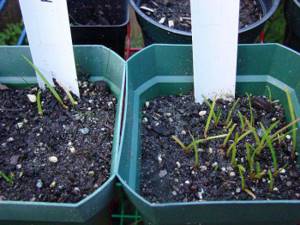
Growing kniphofia from seeds
The transplant should be done carefully. To do this, instead of a spatula, you can use a teaspoon, fork or other small objects. The earthen lump along with the plant is lifted and transferred to the prepared hole. After replanting, the soil is added and pressed down a little with your fingers. You need to grow seedlings on an east or west window so that there is enough sunlight, but it is not too hot.
Planting in open ground is carried out no earlier than the time when the night temperature reaches 10°C. From the pot, the plant along with the soil is transferred into pre-prepared holes at intervals of 30 cm.
Dividing the bush
Adult bushes aged 3 or more years can be propagated by division:
- the kniphofia bush is dug up in April - May and divided into several separate parts; the cut areas are sprinkled with charcoal or crushed activated carbon tablet powder;
- In order for the seedlings to grow faster, you should cut off the rosette of leaves, leaving 15 cm of stem height - this procedure will reduce moisture evaporation and allow the plant to concentrate its energy on the development of new roots.
Immediately after planting in the ground, the plant is watered abundantly. After growth begins and new leaves appear, watering can be reduced to 1-2 times a week. After dividing the bush, Kniphofia will bloom next year.
Knifofia wintering
In autumn, we tie the leaves in bunches and bend them to the ground. We mulch the plantings with sawdust or peat, cover them with spruce branches, and additionally lay roofing material on top. In spring, remove the covering material and trim off yellow, dry, frozen leaves.
If you are afraid that the plant will freeze, you can dig up the bushes in the fall, plant them in large pots with a mixture of sand and peat and store them in a cool room until spring. Moisten the soil in the pot occasionally.
In different climatic zones, wintering of kniphofia is organized differently. In the south, it is able to winter in open ground conditions only if there is shelter. They begin to prepare it in the fall, tying the foliage so that moisture cannot penetrate into the rosettes, and sprinkling it with leaves.
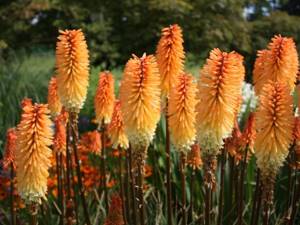
In the north, under no circumstances should kniphofia be left outdoors in the winter - it is dug up, placed in a container with a nutrient substrate and a good layer of drainage, then transferred indoors. The temperature during the winter in this case is maintained at 8 ℃. Replanting is carried out upon the onset of warm weather, when the threat of return frosts has completely passed.
Planting kniphofia in open ground, further care
Otherwise, the inflorescences and leaves will become less bright, and their growth will slow down significantly. Kniphofia should be protected from drafts. They do not tolerate stagnant water well.
Before planting, the soil needs to be loosened and fertilized. The estimated depth is determined based on the height of the plant. A drainage layer is first placed in the hole, and then pre-prepared soil is added.
To ensure that it warms up well, stones covered with dark material are placed near the plantings. Their size may vary.
Kniphophia is a perennial that is resistant to lack of moisture. Therefore, it is not demanding when it comes to watering. Because of this, the flower is planted in areas that have a good drainage system.

Fertilizers are applied in several stages. The first feeding is done immediately after the first foliage appears; a significant reason for carrying out the second stage is the end of the flowering period.
The list of fertilizers used:
- mixtures containing nitrogen;
- peat;
- ash;
- compost;
- humus.
Another mandatory step is pruning. It is held in the spring. If the plant overwintered in open ground, then only after removing the cover. Damaged, yellowed and frostbitten parts of the knifofia must be eliminated. Seeds ripened in capsules are useless.

Plants with winter hardiness (Tukka) can be found in open ground during the cold season in regions such as the Moscow region and central Russia. but even in this case it needs to be covered with a special film, spruce branches and foliage.
Planting in open ground
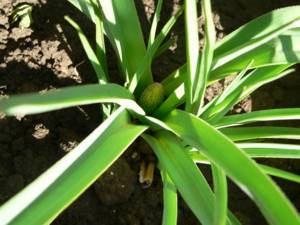
Kniphofia is planted in the garden with the onset of warm weather. There should be at least 40 cm between the bushes. After planting in open ground, it is necessary to monitor the humidity and prevent the soil from drying out for a long time. Seed specimens will begin to bloom in a year with proper care.
Deadlines
In each region, stable warm days occur at different times. Adult plants tolerate temperatures above 0 degrees well, but it is advisable to plant young seedlings in open ground when the temperature is above 8 degrees, preferably 10 - 12.
Landing rules
Before planting, prepare the area:
- dig up;
- bring in sand;
- level with a rake.
Next, take the seedlings out of the pot along with the soil and place them in the holes, covering them with soil. The rosette should be on the surface of the soil.
Home care
Growing the plant is not particularly difficult. The perennial retains high decorative qualities for a long time and serves as a decoration for the garden plot. When growing and caring for kniphofia, you should follow simple rules.
The flower requires sunny, well-lit areas that are protected from drafts and wind.
The soil must drain well. Stagnation of moisture is unacceptable. Loose sandy soil is suitable for kniphofia.
For planting, it is better to choose small hills or use drainage to remove excess moisture.
Transplantation is required if the plant has stopped growing or is sick. There is no need to replant the flower to a new location unless necessary.
Pruning is necessary for kniphofia growing in open ground. It is carried out in early spring, after removing the covering material. During pruning, it is necessary to remove yellowed and frost-damaged leaves. At the end of flowering, it is necessary to cut off the flower stalks. Kniphofia seeds should not be collected, since this is a hybrid species that does not inherit the qualities of the main plant.
Kniphofia, like any ornamental plant, needs feeding. Fertilizer is applied during planting and after the flowering period. It is recommended to use a complex fertilizer containing potassium. Organic fertilizers are applied until green mass and buds appear on the plant.
Kniphofia is resistant to diseases and insect pests. If you follow the rules of caring for a flower, it very rarely gets sick.
Typically, Kniphofia can be affected by insects that damage the leaves. In this case, it is necessary to treat the planting with ready-made insecticidal agents.
With excessive watering, root rot may develop on the flower. If treatment of a plant does not bring a positive result, it should be removed to prevent infection of other plants.
Kniphofia is a heat-loving plant and does not tolerate winter frosts well, so caring for it in different conditions has some differences. In the southern regions, it can overwinter in open ground with a little additional shelter. When preparing the plant for winter, the leaves should be tied into a bundle and covered with a layer of foliage or peat, then covered with spruce branches and plastic wrap.
If the winter is very warm, the root rosettes may rot. To prevent damping off, you should leave several holes for air ventilation in the film. Additional cover is removed in the middle - end of March to adapt the plant to the open air.
In temperate latitudes and northern regions, kniphofia should not be left for wintering in open ground. At the end of autumn, the plant must be dug up and placed in a container or box, which is placed in rooms with a temperature no higher than 10 degrees. The soil should be kept slightly moist during the winter. Transplantation into open ground is carried out after the threat of spring frosts has passed.
Kniphofia is an evergreen plant; leaves should not be cut off before preparing for winter. Otherwise, in the spring, after planting in open ground, it will build up green mass and may not bloom. In spring, remove dried leaves and lightly prune the remaining ones.
Planting and caring for the plant
Since the birthplace of the Kniphofia flower is such hot countries as Africa and no less sunny Madagascar, this must be taken into account when planting a perennial.
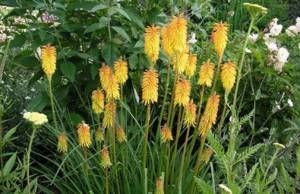
Selecting a location
For the African beauty, sun and light throughout the day are an essential condition for normal development. In shaded areas, kniphofia loses its rich color and its growth slows down. Doesn't like drafts. It grows poorly in lowlands and does not tolerate stagnant moisture.
The soil
This crop is suitable for sandy soils that are well fertilized and loosened. The size of the hole depends on the plant itself - how big it is. A drainage layer must be laid at the bottom of the hole, then fertile soil is added.
Important! Gardeners advise placing pebbles of different sizes near the kniphofia plantings or mulching them with dark-colored material. These procedures will ensure that the soil warms up well.
Watering
Kniphofia is a drought-resistant perennial that does not require frequent watering. Kniphofia is very susceptible to excess moisture, so it is better to plant it in elevated places or areas with a good drainage system.
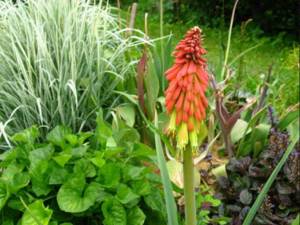
Top dressing
In the spring, as soon as the first green leaves appear, the perennial is fertilized with nitrogen fertilizers. After some time, you can add organic fertilizers in the form of humus, compost, and peat.
After flowering is completed, kniphofia is fed with fertilizers that contain potassium or ash - this way it will receive additional nutrition and overwinter better.
You may be interested in the following ornamental grasses and grains for flower beds: fescue, meadow foxtail, miscanthus, physostegia, turfgrass.
Care
When choosing a place for kniphofia, its planting and subsequent care in the open ground, you must follow certain rules. Proper watering, timely application of fertilizing and fertilizers, pruning of the plant - these are three components that influence the development of the crop and its flowering.
Pruning is done in the spring, immediately after the cover is removed (if the plant overwintered in open ground). Remove frostbitten, yellowed parts of the bush. After the perennial has faded, its flower stalks are removed at the root. There is no point in collecting seeds from plants growing in our latitudes, since they are hybrids and do not inherit maternal characteristics.
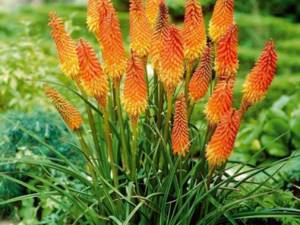
Wintering
In each climatic zone, wintering of kniphofia is carried out in different ways. In the southern regions, the perennial winters in open ground, but it must be covered for the winter. In the autumn, the leaves of the perennial are tied to prevent moisture from entering the rosettes of the plant, sprinkled with foliage or covered with spruce branches, insulation with film is possible. When using film, ventilation holes must be provided; you can simply press the film loosely to the ground, leaving gaps. With such shelter, the plant tolerates frosts with readings down to -15°C.
In the northern regions, kniphofia is not left to overwinter in open ground: it must be dug up and placed in a container with nutritious soil and a good drainage layer. The perennial overwinters in rooms with a temperature not exceeding +8°C.
Types and varieties
In total, there are about 70 species of this plant, most of which are found exclusively in the wild and grow in the hot and dry climate of Africa. Among those cultivated in the middle zone, the following varieties can be noted:
Kniphofia berry (Kniphofia uvaria). This species is one of the tallest, growing more than two meters. This variety began to be cultivated in the 18th century. The most popular varieties are: Kniphofia berry Eskimo, Knifofia berry Martian, Dr. Kerr. At the same time, depending on the difference in varieties lies in the varied color of the flowers;
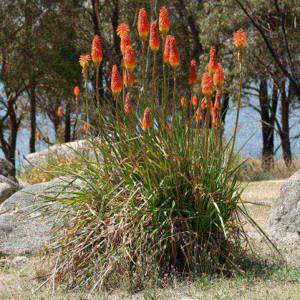
Kniphofia Tukka (K. tuckii). Another variety that is most often found on window sills. This species is one of the most cold-resistant and resistant to changes in climatic conditions. It is also distinguished by its small height, rarely exceeding 80 cm;
You can see it in the title photo.
hybrid kniphofia (K. hybrida). This variety includes artificially created varieties based on berry kniphofia. The most common ones are Fleming Torch, Alcazar, Seliano.
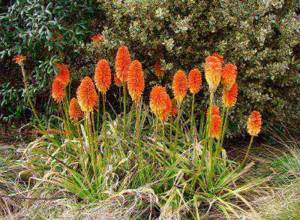
Planting kniphofia in open ground
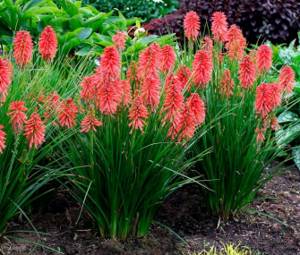
What time to plant
Kniphofia is grown from seeds by seedling method. Sowing is carried out in the last days of March or the first days of April, for this they use boxes filled with soil mixture for flowers, which is pre-disinfected. The top of the boxes should be covered with film. Before seedlings appear, crops can be placed on a windowsill or placed in a greenhouse. They will need systematic ventilation and watering. The first seedlings should appear after 15–20 days, after which they should begin to be accustomed to indoor conditions. To do this, you need to remove the shelter for a while every day, and the duration of the procedure should be increased gradually. When the plants begin to form the first pair of true leaf blades, they will need picking; for this, individual cups are used. It should be noted that this crop reacts extremely negatively to sudden cold snaps, as well as damp and cool weather. In this regard, seedlings should be planted in open soil in July after the return frosts are left behind and warm weather sets in.
Landing rules
Shaded areas are not suitable for planting such a flower, because it is a light-loving plant. The optimal place for planting it will be an elevation located in the southern part of the garden plot. The soil must have good air permeability and be moisture-absorbing. It should be borne in mind that stagnation of liquid in the root system can greatly harm the plant. Sandy soil is best suited for growing such a flower, which needs to be loosened and fertilized before planting.
In the prepared area, you need to make planting holes, between which a distance of 0.3–0.4 m is maintained. These holes need to be spilled with water, after which seedlings are planted in them. The size of the holes should be no less than the volume of the root system of the plant, taken together with the lump of earth. After planting the plants, the holes must be filled with the required amount of soil. The surface of the soil around the bushes is compacted, and the plants themselves are watered.
Outdoor care
If the rules are followed, the African plant Kniphofia takes root well even in temperate latitudes. For beginning flower growers and anyone who is not yet familiar with this interesting perennial, here are recommendations for caring for and carrying out basic agricultural activities.
Watering
The drought-resistant species does not tolerate waterlogging of the soil and excessive moisture during all periods of development. Even during flowering, water is added in moderation as the soil dries. It is useful to let the liquid from the tap sit for one to two days before watering.
Feeding and fertilizer
- The application of nitrogen-based mineral compounds is carried out in the spring to stimulate active vegetation.
- A couple of weeks after the first feeding, organic components are added to the soil: peat, compost, high-quality humus.
- During the flowering period, compounds with potassium and phosphorus are added every two weeks so that the inflorescences are strong and large.
- If the plant overwinters in the ground, then it is advisable to add ash to receive a portion of nutrients and better adapt to the effects of cold.
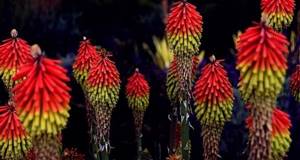
Care during and after flowering
What to do:
- apply mineral fertilizers with a high content of potassium and phosphorus (3:1) for active release of buds and a long season of bright colors;
- water the plant on time. Even such a drought-resistant species as Kniphofia blooms worse when there is a lack of moisture. You cannot flood the plant: the gardener must always remember this;
- check the inflorescences, make sure that there are not many faded buds on the ear;
- It is not practical to collect seeds from hybrid varieties.
Bush formation
Hygienic pruning is performed in early spring, after removing the protective layer from the area where Knifofia overwintered. Be sure to cut off rotten, broken branches and remove all diseased areas.
Mulching, loosening
Helpful Tips:
the African plant loves warm soil and warmth. For this reason, experienced gardeners advise mulching the soil around the bushes with pebbles or pebbles of different sizes (medium and small), and pouring peat mulch on top. Dark natural material attracts sunlight, which improves the flow of heat into the soil. Mulching is carried out throughout the season, especially in cool times. On hot days, the layer of mulch should be thinner, and as the temperature drops, thicker; under a layer of pebbles and peat, weeds reproduce inactively. Weeding is carried out at an early stage of growing Kniphofia, while the seedlings are young
It is important to remove weeds while the seedlings are taking root in the soil, so that pest plants do not interfere with the development of a beautifully flowering species; loosening. If there is no layer of peat and pebbles on the ground, then you need to loosen the soil in a timely manner so that there is no dense crust on the surface
The procedure is carried out on slightly moist soil, and weeds are removed at the same time. Loosening is a mandatory event during the growth of young Kniphofia.
Features of Knifofia
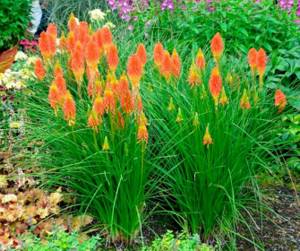
The flowering plant Kniphofia is an exotic perennial that can be evergreen. The height of the bushes varies from 0.6 to 1.5 m. At the same time, the Thomson kniphofia species can have a height of about 300 cm. The short rhizome is quite thick. The basal rosette consists of leathery, sword-shaped leaf plates. From the middle of this rosette grow leafless peduncles that bear plump or spike-shaped apical inflorescences. The inflorescences include drooping small flowers of red, yellow or coral color. This culture has one distinctive feature, namely: the buds (most often red) and flowers (most often yellow) on one bush are painted in different colors. Kniphofia blooms in mid-summer, and the faded bush does not lose its spectacular appearance until late autumn. The fruit is a capsule.
Culture propagation
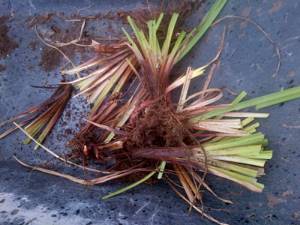
How to divide a kniphofia bush photo
After wintering, adult bushes can be divided.
- Dig up a kniphofia bush in April-early May, divide it into several parts (rhizome with growing points and a bunch of leaves), sprinkle the cut areas with charcoal or powdered crushed charcoal tablets and plant them at a distance of 30-40 cm.
- To make seedlings grow faster, cut off the rosette of leaves, leaving 15-20 cm from the root. This will reduce moisture evaporation, and the plant will expend less energy, directing it to the growth of new roots.
This crop can be propagated by seeds or vegetatively. Most often, in the middle zone, the duration of summer is not enough for the seeds to fully ripen, so the plant is mainly propagated by dividing the bush.
Each adult kniphofia bush over three years old periodically forms stolons, used as planting material for propagation. The separation of daughter rosettes is carried out in early May.
In this case, planting is done in pre-prepared holes, which are filled with nutrient soil. At first, the divisions require abundant watering, which is reduced as the plant matures. Also, immediately after planting, it is necessary to artificially shade the seedling. The first flowering with this method of propagation occurs a year after the division of the plant.
Kniphofia "Poco Yellow"
Kniphofia "Poco Orange"
Seeds
When growing kniphofia yourself, use only purchased seeds. In the second half of March, they are sown in a soil mixture (any soil mixture, just enough that it allows moisture to pass through well, is loose and nutritious). To increase the germination of seeds, the container with the crops is covered with film and left in this position for 2-3 weeks. From time to time, the improvised greenhouse must be ventilated and the soil in it must be moistened.
The emerging shoots are gradually hardened at room temperature, and when two leaves form, the plants are planted in separate containers. In July, the perennial is planted in its designated place. A flower grown in this way blooms in the third year.
Dividing the bush
An easier way to propagate this crop. An adult bush at the age of three years forms daughter rosettes, which are used for propagation. At the beginning of May, the daughter rosettes are separated from the main bush with a sharp knife. The cut is dried and sprinkled with charcoal. After a few hours, the rosettes are planted in previously prepared holes filled with nutritious soil mixture.
Reproduction by dividing the bush is the most suitable for the central part of the Russian Federation. While the seeds are not relevant, a divided specimen will even delight you with the splendor of flowering next year.
There are two methods of propagating kniphofia.
Dividing the bush
When dividing a bush, in early May, the parent seedling is dug up, from which the daughter rosettes are separated. The separated parts of the plant are dried and planted in the ground.
Seeds
Most gardeners propagate bushes using seeds. To do this, ripe seeds are collected from the bush in early autumn. Then they are stored until spring and planted for seedling germination.
The flower can be propagated both vegetatively and using seeds. In the middle zone, the seeds do not ripen, so the crop is most often propagated vegetatively
Typically, dividing the bush is used, for which in late April - early May the bushes are dug up and the daughter rosettes that form in the axils of the lower leaves are carefully separated.
When growing kniphofia from seeds, purchased planting material is used. Seeds are sown in March-April and covered with film for better germination. After 20 days, shoots appear, after which the film is removed, gradually accustoming the seedlings to room conditions. They dive when there are three true leaves and are planted in a permanent place in July. Young plants bloom in 2-3 years.
Planting and caring for the plant
Since the plant is a heat-loving species of perennials, its planting should be approached very carefully. There are several important principles that are recommended to be followed when planting:
- The soil. It is best to plant the plant in sandy soils; they should first be fertilized and loosened well;
- Moisture. Kniphofia does not like excess moisture, so it is recommended to plant it on hills or organize a sufficient amount of drainage in the flowerbed to remove excess moisture;
- Wintering. A prerequisite for normal growth and development of the plant is covering it for the winter. Before creating protection, it is recommended to collect all the leaves in a single bundle and tie it on top. This helps prevent the rhizomes and center of the bush from getting too wet. Next, the bunch is covered with spruce branches and a layer of roofing felt, which will also prevent water from penetrating inside the bush;
- Trimming. There are several stages of pruning, the first of which is done in the spring after removing the winter shelter. At this stage, frozen and yellowed leaves are removed. It is also necessary to trim the flower stalks after flowering, which are removed to the very bottom. If you want to get seeds for seedlings, you can leave a couple of flower stalks;
- Feeding. The application of bait is mandatory at the planting stage and subsequently the application of potash fertilizers is carried out after the completion of the flowering stage. Organic and nitrogenous types of fertilizers are best applied to the soil in early spring before the appearance of green shoots or at the time of bud setting;
A feature of the plant is a high degree of susceptibility to diseases and pests. With proper care, kniphofia rarely gets sick. In rare cases, damage to leaf-eating insects may occur. In such a situation, it is recommended to spray with insecticides. If you over-water, there is a high risk of developing root rot, which can be treated with fungicides. In cases where a plant is terminally ill, it should be immediately removed from the flower garden in order to prevent the “neighbors” from getting sick.
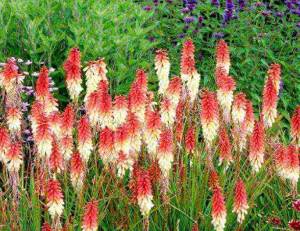
Kniphofia "Orange Vanilla Popsicle"
Kniphofia is a widespread perennial ornamental plant native to Africa. This is a rather unusual plant, ranging from 50 cm to 3 meters in height, having a spike-shaped inflorescence of tubular flowers. The flowers periodically change their bright color from red to orange and yellow, which is clearly visible in the photo. Flowering continues almost all summer - from July until the onset of frost.
Plant care
Growing by seeds and vegetatively and caring for plants is not particularly difficult. It is only necessary to regularly water , weed and mulch the soil. Watering should be moderate, as excessive moisture has a negative effect on the plant. However, on sunny days it is made more abundant.
For the winter period, kniphofia is prepared in a special way to protect it from freezing. After flowering, the flower stalks of the plants are cut off, the leaves are tied into bunches and everything is covered with sawdust, fallen leaves or spruce branches of coniferous trees. The top is additionally covered with roofing felt, leaving small ventilation holes to avoid overheating.
If the winter has little snow or is too wet, the plants may die from freezing. To be on the safe side, kniphofia bushes are transplanted into special containers in which the soil must be periodically moistened . Containers are kept in a dry basement at a temperature of 1-8 degrees. Plants for growing in open ground are planted only in late May - early June.
If the bushes remain hidden in the ground, then they need to be gradually opened to acclimatize to sunlight. It is not recommended to trim the leaves in winter, since kniphofia is an evergreen plant. Otherwise, it may negatively affect flowering. In the spring, before the start of the season, plant care begins, they are inspected, dry leaves are removed and healthy ones are pruned.
Feeding and fertilizing kniphofia
Fertilizer feeding is done twice throughout the entire season. After the appearance of young leaves, fertilizing is carried out with mineral fertilizers containing nitrogen and organic substances. You can use diluted chicken manure. Compost, humus, and peat are used as organic fertilizer . In the second half of summer, after flowering, potassium fertilizers or ash are applied, which helps the plants survive the winter. Near the kniphofias you can place dark stones that emit additional heat necessary for growing flowers.
Pests and diseases
If the plant receives proper care, regular watering, and feeding with the necessary fertilizers, then it is not susceptible to diseases and feels good. Excessive watering can cause root rot.
The method of treating kniphofia in this case is treatment with a fungicide. If the plant can no longer be treated, it must be removed urgently, as there is a risk of infection of other flowers.
Among the insects that can harm the plant are aphids, spider mites, thrips . They are destroyed by spraying with an insecticide.
An exotic plant with a strange name
Kniphofia is a plant native to the African continent. Another name for this flower is tritoma. It belongs to the perennial plant species. A distinctive feature of Kniphofia is the amazingly beautiful flowers located on a thick peduncle emerging from the central part of the rosette of leaves. The length of the stem can reach one and a half meters, while the varietal diversity includes very low-growing plants and varieties, such as Thomson's kniphofia, which grow up to 3 meters in height.
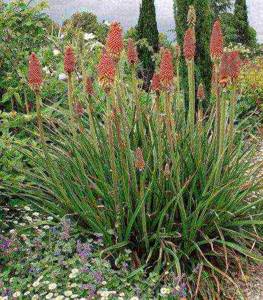
Kniphofia berry
At the top of the peduncle, buds bloom, collected in a spike-like inflorescence. A distinctive feature is that the flowers do not open at once, but gradually, from bottom to top or, conversely, depending on the specific species. If you look at an individual flower, its appearance resembles a bell with a drooping shape.
The color range is varied. At the moment of opening, the flower has red shades; as it blooms, they change from orange to yellow-green.
If you look at the photo of the plant, you can see that it is a bright, colorful spectacle in the form of large plume-shaped inflorescences located on a long stem. Dense gray-green leaves are collected in a thick bunch, which gives the plant additional aesthetics.
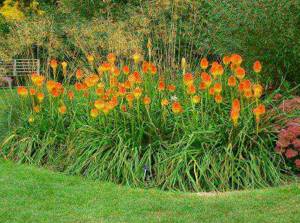
Kniphofia rooperi, "East Cape Poker"
Plant varieties
The birthplace of Kniphofia is the African continent. It has thin gray-green leaves and a bright inflorescence resembling a spike in shape. It consists of many small flowers. At first they have a red tint, and after opening they acquire an orange color, and then gradually shades of yellow. The buds do not bloom all at once. The inflorescence looks impressive due to the combination of small flowers of different shades.
Kniphofia Tukka
This type of kniphofia was discovered in 1892 by a scientist named Tukka. The height of the plant is about 80 cm. The length of the foliage is more than 40 cm. The spike with flowers grows up to 17 cm in length and includes many red-yellow flowers.
This variety has gained popularity among Russian gardeners due to its resistance to cold. Knififia Tukka can even be left in the ground for the winter, but on the condition that it has shelter.
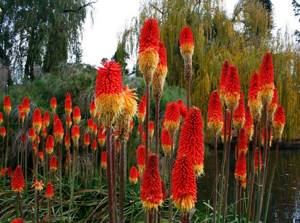
Kniphofia berry
In nature, this species is found only in the Cape Province. The plant reaches a height of 1.5-2 m. The length of the sword-shaped leaves of a gray-green tone is about 50 cm. The inflorescences reach a length of 25 cm, the lower leaves are yellow-green, and the upper ones are bright red. Flowering lasts almost 9 weeks. The following varieties are cultivated:
- Large-flowered form - the height of the stem reaches 1.3 m. The length of the inflorescences is up to 30 cm. They consist of bright red flowers.
- Dr. Kerr - the stems grow up to a meter long. The height of the inflorescences is about 20 cm, they consist of soft yellow flowers.
- Orange Beauty - the length of the plant reaches 1 m. It has flowers of an orange tone.
- Eskimo - bushes grow up to 1 m. The flowers located in the lower part of the variety are yellow. At the same time, the upper ones can vary in color from red-coral to orange.
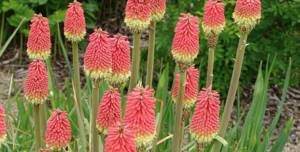
Kniphofia hybrid
This category includes all varieties and hybrids obtained from the cultivation of Kniphofia berry. The most popular of them are:
- Abendzonne - flowers 1.2 m high, consisting of yellow (bottom) and red (top) inflorescences.
- Cardinal - the bush grows up to 1.2 m. The flowers are painted in a fiery red tone.
- Bernox Triumph is a low-growing variety with a height of 60 cm. The flowers have a bright orange tone.
- Golden Skepter - flower height - 1.2 m. The inflorescences consist of small bright yellow flowers.
- Indiana - the height of the crop does not exceed 1 m. The inflorescences include red-orange flowers.
- Prince Maurito is a bush that reaches 1.2 m, decorated with large red-brown inflorescences.
- Rocket - distinguished by large red-cinnabar inflorescences, reaching a length of 1.3 m.
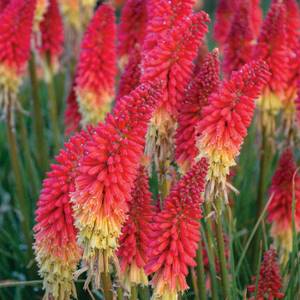
Types and varieties of kniphofia
The types and varieties of kniphofia used in gardening are described below.
Kniphofia tuckii.
It is an evergreen herbaceous plant about 80 cm high. The leaf blades are bright green, 40 cm long, narrow, pointed at the base, and sword-shaped. The inflorescences are oblong, about 15 cm long. The buds are yellow-red. This type of Kniphofia flower has increased frost resistance, which is why it is especially popular among gardeners in central Russia. Tolerates winter well and does not require shelter.
Kniphofia uvaria.
Tall bush, reaching 2 m in height. The leaf blades are green, pointed bases, 50 cm long. The inflorescences are large, about 25 cm long. The lower flowers are yellow-green, the upper ones are bright red. Flowering of this species lasts for 2 months.
Varieties of Kniphofia berry:
“Large-flowered” is a bush up to 1.5 m high. Long inflorescences, reaching 30 cm, consist of fiery red flowers. This variety is one of the most attractive among the kniphofia varieties;
"Doctor Kerr" is a bush 1 m or more high. The inflorescences are 20 cm long and consist of bright yellow flowers;
"Orange Beauty" - a bush 1 m high. The flowers are bright orange;
"Fire Flame" - a variety with red flowers;
“Eskimo” is a bush 1 m high. The lower flowers of this variety are yellow, the upper ones can have a variety of shades: red, orange, coral, pink;
"Flamenco" - red-yellow flowers;
“Surprise” has deep pink flowers that fade to yellow at the top.
Hybrid Kniphofia (Kniphofia x hybrida).
This species appeared as a result of mixing different types of kniphofia. Most varieties of this species are bred on the basis of Kniphofia berry. Some of them are described below.
Varieties of hybrid kniphofia:
“Abendzonne” is a bush about 1.2 m high. The lower flowers are lemon-colored, the upper ones are red;
"Cardinal" - deep red flowers;
"Burnox Triumph" is a low-growing variety with a height of no more than 60 cm. The flowers are bright orange;
"Golden Scepter" - bright yellow flowers;
"Indiana" - red-orange flowers;
"Royal Standard" - the lower flowers are yellow, the upper ones are scarlet-red;
"Prince Maurito" - red-brown flowers;
"Theo" - red-orange flowers;
"Rocket" - red-cinnabar flowers"
"Fleming Torch" - yellow-red flowers;
"Alcazar" is an early flowering variety that blooms in June. The flowers are bright orange;
"Little Maid" - light yellow flowers;
"John Benary" - red flowers. Flowering from August to late autumn.
What the types and varieties of kniphofia flowers look like can be seen in the photo selection shown below:
Caring for kniphofia in the garden
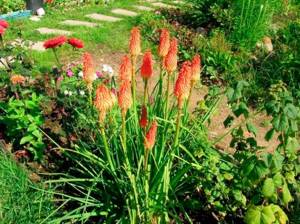
Growing kniphofia in your garden plot is quite simple. During the first season after the plant is planted in open soil, it must be systematically watered, loosen the soil surface, and also remove weeds from the area. The first flowering can be seen only in the next season and only if the plant’s root system is well strengthened. And for this it is necessary to moisten the soil in a timely manner, but moderately, and also to carry out weeding and loosening of the soil.
How to water and feed
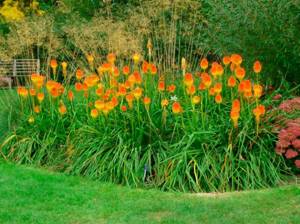
Watering is carried out only after the top layer of soil has dried. If the weather is hot and dry, then you will have to water the kniphofia more often than usual. To reduce the number of weeding, loosening and watering, it is recommended to cover the surface of the area with a layer of mulch (sawdust or peat).
Feeding the bushes is carried out at the beginning of the spring, before the green stems grow or during the formation of buds. To do this, use nitrogen-containing fertilizers or organic matter, and when the bush fades, it is fed with potassium mineral fertilizer.
Wintering
When grown in mid-latitudes, such a crop is not long-lived, but for several seasons Kniphofia will be able to decorate your garden. All the arrows of a faded bush need to be cut out, but there is no need to touch the foliage. When preparing a flower for wintering, its leaf plates are carefully tied, then the bush itself must be covered with a layer of peat chips, which are sprinkled with spruce branches on top. On top of such a shelter you need to lay a moisture-proof covering material, for example, film or roofing felt. In spring, the cover from the bushes must be removed. Then inspect the bushes and cut off any frost-damaged or yellow leaf blades.
Transfer
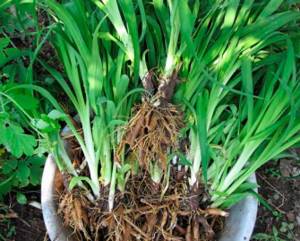
If you dig up a bush for the winter and bring it into the house, then you can extend its life. To do this, the flower is removed from the soil, then it is planted in a large pot and placed in a cool room for the winter. Make sure that the root system of the kniphofia does not dry out; to do this, it should be watered with a small amount of water if necessary. The bush is planted in open soil in the last spring or first summer weeks.
Diseases and pests
If you strictly adhere to the agrotechnical rules of this crop and properly care for kniphofia, the flower will rarely get sick. Leaf-eating pests can settle on it. If this happens, the bushes need to be treated with an insecticidal solution.
If you water such a flower too often and abundantly, this can cause rot on the root system. The plant can only be saved if the disease is detected at the very beginning of its development. To do this, the bush and the surface of the soil around it are treated 2 or 3 times with a solution of a fungicidal preparation. If the kniphofia is very badly affected by rot, then it should be removed from the ground and destroyed. If this is not done, the infection may spread to neighboring plants.
https://youtube.com/watch?v=QAtMMFuUJew
Features of caring for kniphofia in the garden
When choosing a kniphofia plant, planting and care in open ground must meet a number of requirements. Timely watering, regular fertilization, pruning and replanting of plants - all these procedures affect the development and flowering of the crop.
Trimming
Chrysanthemum Bacardi - planting and care in open ground
Pruning is carried out in the first half of spring, immediately after the winter shelter is eliminated. Frozen and yellowed parts of the plant must be removed. The following procedure is carried out when the kniphofia fades. At this time, all flower stalks are cut off at the root.
For your information! It is not advisable to collect seeds, since all hybrids growing in Russian latitudes lack maternal characteristics.
Watering
Since Kniphofia Alcazar and its other varieties are drought-resistant varieties, watering them is often not recommended. The plant does not tolerate excessive humidity quite well, so it is better to choose a flat or elevated place for planting.
Humidity
It is best to plant the perennial kniphofia shrub in a climate zone with an average level of humidity or close to dry. The spraying procedure is kept to a minimum.
Priming
This plant, like grandiflora, is best grown in sandy soil. Before planting, it should be thoroughly fertilized and loosened. The hole for the plant is dug based on the size of the kniphofia itself.
Important! The plant needs good drainage.
A layer of pebbles or gravel is placed at the bottom, followed by fertile soil. Many gardeners recommend laying stones on the ground near the planting or mulching with dark materials. This procedure will allow you to attract more sunlight and heat to the flower.
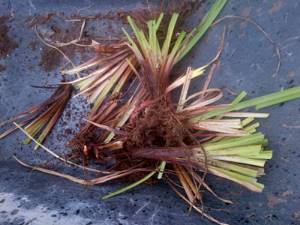
Kniphofia planting procedure
Feeding
To grow a healthy plant, it is very important to carry out timely feeding. The first fertilization is carried out with nitrogen compounds after the first leaves appear. After 2-3 weeks, organic matter in the form of peat, compost or humus will be suitable.
After flowering, the plant will need additional nutrition to prepare for winter. At this time, it is recommended to use wood ash or potash fertilizers.
